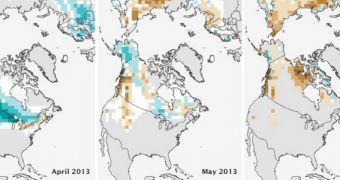Throughout 2013, Arctic sea ice loss was comparable to levels recorded over the past few years, but also much larger than the long-term average recorded between 1979 and 2010. During the critical time of spring, the North Pole lost large volumes of ice, significantly influencing global climate.
According to scientists at NASA, sea ice changes that occur during the spring are more likely to affect global warming patterns than melts or ice growths occurring at any other time in the year. Spring melt occurs between March and June, when sunlight can finally be seen over the Arctic after months of darkness.
In the Eurasian Arctic, a new record-low sea ice extent was established in May 2013, where values were much lower than the long-term average. The conclusion belongs to the new Arctic Report Card released by the US National Oceanic and Atmospheric Administration.
The image above shows Arctic sea ice anomalies recorded for the months of April, May and June, as compared with long-term values. Redder and brown colors represent days with a reduced snow cover percentage, while bluer hues are used to denote days with more ice at those particular locations.

 14 DAY TRIAL //
14 DAY TRIAL //